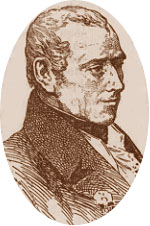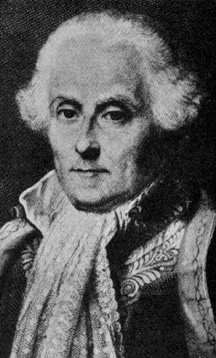
Laplace

1749-1827
His Life and his Works
Pierre Simon, Marquis de Laplace was born in 1749, into the noble Laplace family. Always avid of scientific knowledge, he moved to Paris at the age of 18 to prove his worth. This he succeeded in doing to the mathematician Jean le Rond d'Alembert. Thus breaking into the French scientific circles, he became professor at the Ecole militaire de Paris at a surprisingly young age. He later went on to obtain a seat in the Senate (1799) and then to become its vice president and chancellor (1803). Laplace was one of the few thinkers of the time to actually survive the Revolution and the ensuing regime of `La Terreur`. He was later appointed Minister of the Interior by Napoleon, before being dismissed with the comment that "he carried the spirit of the infinitely small into the management of affairs" (from Boyer). Finally, he was elected to `L'Academie Francaise` in 1816.
He is most known for his work on
mathematical astronomy, putting in place some of the final and definitive ideas
of celestial motion. His entire work in this field is recorded in his five
volume work `Mecanique Celeste` (1799-1825). In this volume he summarized
and expanded the work of all his predecessors. However, even though this work
was and remains an essential piece of study, the text contains omissions and
lackings which are simply covered by a `it is obvious to see`. 
In these works, with the collaboration of J.L.Lagrange, Laplace proved beyond a doubt Newton's theory of gravitation, translating Newton's mechanical studies to a calculus based system, giving birth to Mechanical Physics. Another important part was his studying of the variations of the Moon's motion relative to Earth, taking into account the eccentricities of the planet's orbit and thus solving this age old problem. This lunar presentation was completed by the tidal effect of the satellite on its planet. Laplace also presented here observations on the 2 major gas giants, Jupiter and Saturn, their unequal motions and the movement of their satellites.
Another more popular astronomical work of Laplace's is his `Exposition du Systeme du Monde` (1796) in which he also includes a brief history of the Solar System and the presentation of his nebular theory for its formation. He effectively proposed that the planets formed from the coalition of rotating dust particles around the Sun, coming together to form solids objects at set distances from their star. After reading these revolutionary works, Napoleon is said to have questioned Laplace's failure to mention God, to which the scientist replied, "I have no need for that theory".
Other important works of his include `Theorie des attractions des spheroides et de la figure des planetes`(1785) as well as two works on probabilities, the `Theorie analytique des probabilites`(1812) and `Essai philosophique sur les probabilites`(1814). The first presented Laplace's coefficients and his potential function, whereas the latter were the first real systematic studies of probability.
Laplace speculated that light traveled adiabatically, allowing the explanation of Newton's studies. He also proposed the theory of interparticulate forces, potentially applicable to most observed scientific phenomenon. This was later superceded but remains an important initial principle.
Subscribing to Lavoisier's
calorimetric
theory, they carried out several experiments together. Using a calorimeter, they
estimated the heat evolved per unit of carbon dioxide produced.